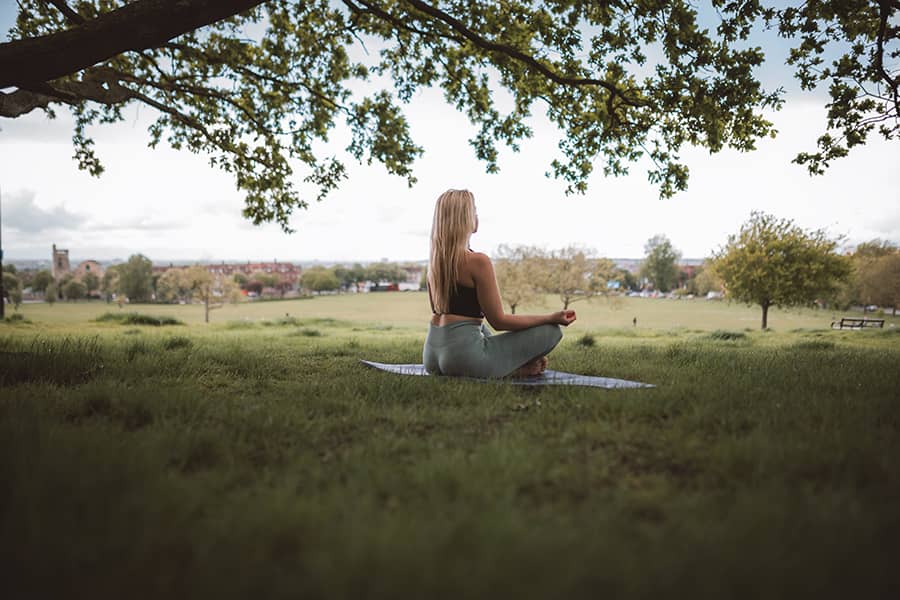
In today’s fast-paced digital age, where notifications continually buzz and immediate responses are often expected, there’s a growing sense of being perpetually “on.” Consequently, the emotional and mental strains of this non-stop connectivity can leave us feeling frazzled and overwhelmed. However, amidst this whirlwind of daily obligations and digital distractions, an ancient solution beckons. Mindfulness and meditation, age-old practices, offer a serene refuge from the frenetic world around us. Not only do these methods provide a momentary escape, but they also arm us with tools to cultivate lasting inner peace. As we delve deeper into this topic, we’ll uncover the transformative power of being present and the tranquility that consistent meditation can bring. So, whether you’re a seasoned practitioner or a curious beginner, join us as we explore the pathways to inner serenity. Because, in our ever-busy lives, the promise of peace might just lie in the simple act of a mindful pause.
Table Of Content
- Understanding Mindfulness
- Delving into Meditation
- The Science Behind Mindfulness and Meditation
- Practical Ways to Introduce Mindfulness into Daily Life
- Starting Your Meditation Journey
- Meditation for Beginners: Finding Your Footing
- Deepening Your Meditation Practice
- Advanced Meditation Techniques: Taking Your Practice Deeper
- Mindfulness and Children: Cultivating Presence from a Young Age
- Conclusion: The Timeless Essence of Mindfulness and Meditation
Understanding Mindfulness
1. Defining Mindfulness: The Ancient Practice in Modern Times
Immediately following our introduction to inner peace amidst daily chaos, a pivotal question arises: What, precisely, is mindfulness? In today’s wellness-oriented circles, this term frequents conversations. However, it’s vital to understand that mindfulness transcends being a mere trend; it’s a profound practice deeply embedded in history. At its most basic, mindfulness champions the concept of present moment awareness, a conscious act of directing one’s attention to the current moment, unfettered by judgment or distraction.
2. Mindfulness in the Digital Age
With the digital age’s ascent, where attention spans are constantly under siege, mindfulness’s significance has magnified. This era, laden with fleeting notifications and instantaneous responses, demands a tool to anchor our scattered minds. Practicing mindfulness not only grounds our thoughts but fortifies mental resilience, enabling more effective navigation through modern life’s inevitable stressors.
3. Tangible Benefits of Mindful Living
Embracing mindfulness in daily routines manifests a plethora of benefits. For instance, those dedicated to mindful living frequently cite enhanced concentration, regulated emotions, and a richer connection with their environments. Given our world’s relentless pace, these benefits transform from mere luxuries to undeniable necessities.
4. Integrating Mindfulness: A Sneak Peek
As we progress, we’ll explore the tangible intersections of mindfulness with daily life and the methodologies to harness its potential. From mindful eating to mindful walking, we’ll unveil techniques to infuse routine moments with purpose and consciousness. At the heart of it all, remember: sometimes, the journey to inner serenity is just a mindful breath away.
Delving into Meditation
1. Meditation: A Deep Dive Beyond Mindfulness
Having explored the intricacies of mindfulness, we now turn our focus to its deeper, often more structured counterpart: meditation. While mindfulness signifies present moment awareness, meditation offers a set of tools and techniques to consistently achieve this state of being.
2. The Landscape of Meditation Techniques
Throughout history, civilizations have developed myriad meditation techniques to enhance well-being. From the deep tranquility of Transcendental Meditation to the introspective pathways of Vipassana, there’s a wealth of methods awaiting exploration. These practices not only promote mental clarity but also foster emotional balance, making them essential in our fast-paced world.
3. The Science-Backed Benefits of Meditation
Recent studies continually illuminate the profound impact of meditation on mental health and stress reduction. Individuals integrating daily meditation report lowered anxiety levels, enhanced concentration, and a robust emotional equilibrium. In today’s age, where digital distractions reign supreme, meditation emerges as a sanctuary for the mind.
4. Embracing Mindfulness Meditation in Daily Routines
Within the broad meditation umbrella, mindfulness meditation techniques stand distinct. Concentrating on the present, these practices champion observing thoughts non-judgmentally, thus deepening daily experiences and interactions. For those keen on weaving mindfulness into everyday moments, this form is a perfect starting point.
5. Gearing Up for the Meditation Journey Ahead
As we transition further, we’ll demystify the steps to kickstart a successful meditation practice in modern life. From curating a serene meditation environment to addressing typical beginner hurdles, upcoming sections are tailored to guide both novices and seasoned practitioners.
The Science Behind Mindfulness and Meditation
1. Unveiling the Neurological Magic
Starting with the brain itself, meditation isn’t just a mental exercise—it induces tangible changes at the neural level. Research has shed light on how consistent meditation practices lead to neuroplasticity. This fascinating process allows the brain’s neural pathways and synapses to modify, enhancing key functions such as focus, emotional regulation, and even creativity.
2. The Stress-Reduction Phenomenon
Moving on to stress, a malaise of our times, one cannot overlook the profound stress-relieving effects of mindfulness. Cortisol, our primary stress hormone, sees significant reductions in consistent meditators. This decline doesn’t merely reduce anxiety; it also ushers in benefits like improved sleep, better digestion, and an overarching sense of well-being.
3. Enhancing Emotional Intelligence
Transitioning to emotional health, it’s noteworthy how our emotional epicenter, the amygdala, undergoes transformations with regular mindfulness practices. Consequently, there’s a heightened emotional awareness and improved regulation. This evolution doesn’t stay confined to the self—it manifests in healthier interpersonal relationships, deeper empathy, and a more refined understanding of one’s emotional reactions.
4. Boosting Memory and Concentration
Shifting our focus to cognitive abilities, the influence of mindfulness and meditation on memory and concentration is remarkable. The hippocampus, our neural hub for memory and learning, becomes more active in those weaving meditation into their daily life, leading to sharper memory retention and heightened concentration.
5. Physical Health Improvements
Lastly, in the realm of physical health, it’s astonishing how a practice rooted in mental well-being can have such profound physical repercussions. Numerous studies highlight benefits like lowered blood pressure, bolstered immune response, and even cellular-level anti-aging effects. It’s a testament to the deep interconnection between our minds and bodies.
Practical Ways to Introduce Mindfulness into Daily Life
1. Mindful Mornings
Starting the day with intention can set the tone for everything that follows. Before reaching for your phone or diving into tasks, take a few moments to sit quietly, breathe deeply, and set an intention for your day. This mindful morning ritual can provide clarity and a calm demeanor, no matter what the day holds.
2. Mindful Eating
Switching gears to our dining habits, how often do we eat without truly tasting our food? Mindful eating involves savoring each bite, appreciating the flavors, and truly being present during meals. Not only can this enhance your culinary experience, but it also aids in digestion and ensures you’re in tune with your body’s hunger and fullness cues.
3. Mindful Commuting
For those who commute, instead of viewing it as ‘lost time’ or a source of stress, turn it into an opportunity for mindfulness. If you’re driving, be fully present with the act, noticing the sensations of the wheel, the rhythm of the road, and even your breath. For public transit users, it’s a chance to observe, reflect, and perhaps even meditate.
4. Mindfulness Breaks at Work
Navigating the workday hustle, it’s easy to get lost in the chaos. Introduce short mindfulness breaks—maybe five minutes every hour—to simply breathe, stretch, or even take a brief walk. These moments can recharge your mind, boost productivity, and reduce stress levels.
5. Mindful Technology Usage
Lastly, in our digital age, where screens are omnipresent, it’s vital to practice mindful technology use. Set specific times to check social media, take regular screen breaks, and perhaps have a digital detox day once a week. It’s not about shunning technology but using it with awareness and intention.
Starting Your Meditation Journey
1. Crafting the Perfect Meditation Space
Embarking on a meditation journey begins with setting up an environment conducive to tranquility. Whether it’s a dedicated corner in your home or a quiet spot in your garden, your chosen space should resonate with calmness. Prioritize elements like soft lighting, comfortable seating like meditation cushions or ergonomic chairs, and perhaps subtle fragrances from essential oils for relaxation. A harmonious environment not only aids deeper meditation but also instills a daily practice habit.
2. Tools and Apps to Guide Your Practice
In our digital wellness age, there’s an abundance of resources to assist newcomers. Meditation apps like Headspace and Calm offer guided sessions, ranging from beginner tutorials to advanced practices. Additionally, online platforms often feature meditation music playlists and soundscapes that can further enhance your focus and experience.
3. Setting Realistic Meditation Goals
It’s vital to approach meditation with patience. Instead of aiming for extended hours initially, start with short 5-minute daily meditation sessions. Gradually, as your comfort and concentration develop, you can extend these durations. Setting achievable goals ensures consistent progress without feeling overwhelmed or discouraged.
4. Navigating Common Meditation Hurdles
Every beginner encounters challenges. From restless thoughts to physical discomfort, it’s essential to recognize these as part and parcel of the learning curve. Equip yourself with knowledge about common meditation misconceptions and solutions, ensuring a smoother journey. Remember, every practitioner, at some point, faced these hurdles; persistence is key.
5. Embracing the Meditative Lifestyle Beyond Sessions
True meditation transcends the designated practice moments. It’s about integrating that calm, focused state into everyday activities. From mindful eating to walking meditation, there are myriad ways to weave the essence of meditation into daily life, making mindfulness more than a practice – a lifestyle.
Meditation for Beginners: Finding Your Footing
1. Understanding the Basics
First and foremost, meditation isn’t about emptying your mind but rather observing your thoughts without judgment. At its core, it’s a practice of awareness and presence. Starting your journey with a clear understanding of this can make the process less daunting and more enriching.
2. Setting the Right Environment
Transitioning to the physical aspect, a calm and quiet environment can significantly enhance your meditation experience. Choose a location free from distractions, maybe with soft lighting, and consider using soothing meditation music or ambient sounds. Remember, comfort is key, so have a cushion or chair that supports your posture.
3. Establishing a Routine
Consistency is the backbone of any successful meditation practice. It’s better to meditate for a few minutes daily than for hours once in a while. Designate a specific time each day, whether it’s upon waking up, during lunch breaks, or before sleep, to cultivate this habit.
4. Guided Meditation as a Starting Point
If you’re uncertain about starting solo, consider guided meditations. Numerous meditation apps and websites offer narrated sessions that can guide you through the process, making it easier for beginners to immerse themselves without feeling lost.
5. Embracing Patience and Persistence
Lastly, it’s crucial to understand that meditation is a journey, not a destination. Some days might feel more fruitful than others, and that’s okay. The act of returning to your practice, even when it feels challenging, speaks volumes about your dedication and will yield benefits over time.
Deepening Your Meditation Practice
1. Recognizing the Importance of Consistency
One of the fundamental truths about meditation is that its effects compound with time. Much like physical fitness, achieving a deeper state of mindfulness requires consistent effort. Committing to daily meditation routines, even if it’s just for a few minutes, fosters a deeper connection with oneself and amplifies the practice’s benefits over time.
2. Experimenting with Various Techniques
As you grow more comfortable with basic meditation, it’s enriching to explore different modalities. From guided imagery meditation to Zen and chakra balancing, there’s a vast universe of techniques awaiting your discovery. Diversifying your practice can not only prevent stagnation but also help in addressing specific emotional or mental challenges.
3. Joining Meditation Communities
There’s an undeniable power in collective energy. Engaging with local meditation groups or online meditation communities can bolster your practice. Sharing experiences, asking questions, and meditating in groups can offer fresh insights and strengthen your commitment to the journey.
4. Deepening Awareness with Meditation Retreats
For those keen on immersive experiences, participating in meditation retreats offers a profound dive into self-awareness. Often set in serene locations, these retreats allow practitioners to disconnect from daily distractions and reconnect with their inner self, under the guidance of experienced teachers.
5. Measuring Progress and Celebrating Milestones
While meditation isn’t about goal-setting in the traditional sense, it’s still vital to acknowledge growth. Journalling your experiences post-meditation, noting the challenges and breakthroughs, can serve as a valuable tool. Celebrate milestones, be it achieving a longer meditation duration or successfully implementing a new technique, to fuel motivation.
Advanced Meditation Techniques: Taking Your Practice Deeper
1. Vipassana Meditation
Delving deeper into the meditation realm, Vipassana stands as one of the oldest meditation techniques from India. It involves observing the subtle sensations in the body and understanding the impermanence of life. Often practiced in 10-day retreats, Vipassana can be a transformative experience, diving deep into self-exploration and insight.
2. Kundalini Meditation
Shifting focus to the energy centers, Kundalini meditation aims at awakening the dormant energy at the base of the spine. This powerful form of meditation combines mantra chanting, pranayama (breathwork), and specific postures to channelize energy upwards, leading to heightened states of consciousness.
3. Zen Meditation (Zazen)
Rooted in Buddhist tradition, Zazen or Zen meditation involves seated meditation focusing on the observations of the thoughts and sensations without attachment. It’s a discipline that demands dedication but offers profound clarity and heightened mindfulness in return.
4. Transcendental Meditation (TM)
Moving on to a more mantra-centric approach, Transcendental Meditation requires practitioners to silently repeat a specific mantra for 20 minutes, twice a day. Promoted for its stress-reducing benefits, TM has garnered attention globally, with many celebrities endorsing its transformative potential.
5. Yoga Nidra
Lastly, toeing the line between wakefulness and sleep, Yoga Nidra, also known as yogic sleep, is a state of conscious relaxation. While lying down, practitioners are guided through a systematic relaxation process, leading to deep rejuvenation and often profound insights.
Mindfulness and Children: Cultivating Presence from a Young Age
1. The Rising Need for Mindfulness
In today’s hyper-connected era, children face a barrage of stimuli from screens, academic pressures, and the bustling pace of modern life. This onslaught can lead to stress and attention fragmentation even in the youngest minds. Hence, introducing mindfulness early can equip them with tools to navigate their world with clarity and calmness.
2. Simple Techniques Tailored for Children
Starting with the basics, kids can benefit from simple breathing exercises, listening to the sounds around them, or even a mindful nature walk. These exercises ground them in the present moment and help them recognize and manage their emotions more effectively.
3. Benefits: Beyond Just Calmness
Moving beyond mere relaxation, introducing mindfulness to children can enhance their concentration, boost empathy, improve sleep patterns, and foster a deeper sense of gratitude and joy. It’s not just about being calm; it’s about nurturing a holistic understanding of oneself and the world.
4. Mindfulness Through Play and Activities
Integrating into their language, play-based mindfulness activities like mindful coloring, sensory bins, or even guided storytelling can be effective. It’s about making the practice enjoyable and relatable, tapping into their natural curiosity and playfulness.
5. Building a Mindful Family Environment
Lastly, it’s essential to recognize that children often mirror their surroundings. Creating a mindful family environment, where parents or guardians practice and prioritize mindfulness, can have a ripple effect. Regular family meditation sessions or simply practicing active listening at the dinner table can make a world of difference.
Conclusion: The Timeless Essence of Mindfulness and Meditation
In a world that constantly bombards us with stimuli, the allure of mindfulness and meditation grows ever stronger. From the foundational understanding of their principles to the deeper nuances of advanced techniques, it’s evident that these practices are more than just fleeting trends; they’re lifelines in our ever-evolving landscapes.
Our journey through this article has unveiled the powerful transformative stories of individuals from diverse backgrounds. Be it the corporate hustler, the anxious student, the bereaved soul, or the artist in search of inspiration, the tapestry of success stories underlines the universal applicability and profound impact of these practices.
Furthermore, the importance of introducing mindfulness to children underscores a fundamental truth – it’s never too early, or too late, to start. With the digital age’s challenges and distractions, giving the younger generation the tools to navigate their emotions and environment is not just beneficial – it’s imperative.
To those teetering on the edge of beginning their mindfulness journey – dive in. Let the insights, techniques, and stories shared here be your guiding light. As we’ve seen, the path of mindfulness and meditation is paved with transformation, self-awareness, and an unshakeable inner peace.








Leave a Reply